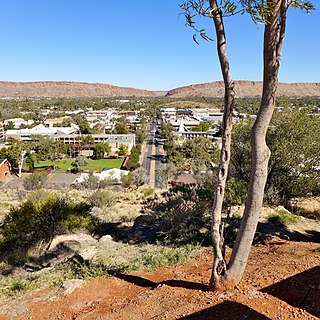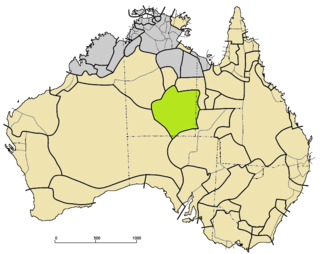
Kathleen Kemarre Wallace (born 1 July 1948), is an Eastern Arrernte artist, author, custodian and cultural leader from Ltyentye Apurte in the Northern Territory of Australia. [1]

Kathleen Kemarre Wallace (born 1 July 1948), is an Eastern Arrernte artist, author, custodian and cultural leader from Ltyentye Apurte in the Northern Territory of Australia. [1]
Wallace was born near Ltyentye Apurte, a remote area of Central Australia. She is senior Eastern Arrernte speaker. Her family kept her away from stations and missions to prevent her removal under the Aboriginals Ordinance 1918 Act. [2] When she was 13, her family was forced to move to Santa Teresa Mission, now Ltyentye Apurte Community. This move was caused by severe drought and the interruption of traditional hunting and food gathering by encroaching station activities. [3]
Wallace has lived on her homelands her whole life and she has always viewed it as her responsibility to ensure traditional knowledge is handed on; especially through art and storytelling.
In 1989 she was a founding member of Keringke Arts and, since then, has become one of their most successful artists and her work is represented in many national and international collections. [3]
Her artworks are very influenced by her Catholic faith and she says:
When I went to Santa Teresa, nuns taught me the Bible. When I came to Santa Teresa I couldn't speak English — I learned it there," she said. [Catholicism and my family's traditional beliefs] are similar — it wasn't hard for me. My grandfather's ancestors gave him a dream of three circles — grandfather, father and totem spirit — like the Holy Trinity.
— Kathleen Kemarre Wallace, [2]
Wallace has published two books Plants of the Santa Teresa region of Central Australia and Listen deeply: let these stories in.
In October 2019 the stained glass window that Wallace designed was installed at the Our Lady of Sacred Heart Catholic Church in Alice Springs which is celebrated for showing the blending of Catholic and Indigenous beliefs. [2] The title of the painting, which became the stained glass is Urtakwerte Atywerrenge Anthurre or, in English, Very Sacred Heart and it depicts the Virgin Mary and Jesus standing on a sandhill and different parts of the painting representing different aspects of her blended faith. [4] She also was a senior advisor on the Indigemoji app launched in 2019. [5] This app provides 90 emojis representing central Australia's Indigenous Arrernte culture and is Australia’s first set of Indigenous emojis. [6] [7]
In addition to being an artist Wallace has worked as a teacher and served her community as an elected councillor for Ltyentye Apurte as well as being a member of the executive committee of Desart. [1]
Wallace and her husband Douglas had no children of their own but they have raised more than 30 children throughout their marriage; taking in children when they were neglected or their parents were drinking. This earned her the nickname "Mum". [1] [3]

Alice Springs is the third-largest town in the Northern Territory of Australia. Known as Stuart until 31 August 1933, the name Alice Springs was given by surveyor William Whitfield Mills after Alice, Lady Todd, wife of the telegraph pioneer Sir Charles Todd. Known colloquially as 'The Alice' or simply 'Alice', the town is situated roughly in Australia's geographic centre. It is nearly equidistant from Adelaide and Darwin.
The Central Australian Aboriginal Media Association (CAAMA) is an organisation founded in 1980 to expose Aboriginal music and culture to the rest of Australia. It started with 8KIN-FM, the first Aboriginal radio station in the country. Based in Alice Springs, the organisation is particularly focused on the involvement of the local Indigenous community in its production. CAAMA is involved in radio, television and recorded music.

Hermannsburg, also known as Ntaria, is an Aboriginal community in Ljirapinta Ward of the MacDonnell Shire in the Northern Territory of Australia, 125 kilometres (78 mi); west southwest of Alice Springs, on the Finke River, in the traditional lands of the Western Arrarnta people.

Wenten Rubuntja was an Australian artist, Aboriginal rights activist, and historian.

Aṉangu is the name used by members of several Aboriginal Australian groups, roughly approximate to the Western Desert cultural bloc, to describe themselves. The term, which embraces several distinct "tribes" or peoples, in particular the Ngaanyatjarra, Pitjantjatjara and Yankunytjatjara groups, is pronounced with the stress on the first syllable: [ˈaɳaŋʊ].

Arrernte or Aranda or sometimes referred to as Upper Arrernte, is a dialect cluster in the Arandic language group spoken in parts of the Northern Territory, Australia, by the Arrernte people. Other spelling variations are Arunta or Arrarnta, and all of the dialects have multiple other names.

Rosalie Lynette Kunoth-Monks, also known as Ngarla Kunoth, was an Australian film actress, Aboriginal activist and politician.

Marsdenia australis, commonly known as the bush banana, silky pear or green vine is an Australian native plant. It is found in Central Australia and throughout Western Australia. It is a bush tucker food used by Indigenous Australians.

The MacDonnell Regional Council is a local government area of the Northern Territory, Australia. The region covers an area of 268,329 square kilometres and had an estimated population of 6,863 people in June 2018.

Rachel Perkins is an Australian film and television director, producer, and screenwriter. She is known for her films Radiance (1998), One Night the Moon (2001), Bran Nue Dae (2010), and Jasper Jones (2017). Perkins is an Arrernte and Kalkadoon woman from Central Australia, who was raised in Canberra by Aboriginal activist Charles Perkins and his wife Eileen.
The Ltyentye Apurte Community, also known as Santa Teresa, is an Arrernte indigenous community in the Northern Territory, Australia, located about 80 kilometres (50 mi) south-east of Alice Springs.

Haasts Bluff, also known as Ikuntji, is an Aboriginal Australian community in Central Australia, a region of the Northern Territory. The community is located in the MacDonnell Shire local government area, 227 kilometres (141 mi) west of Alice Springs. At the 2006 census, the community, including outstations, had a population of 207.
Thomas Sidney Dixon was a Catholic missionary known for his work with Indigenous peoples. He took up the cause of Max Stuart, an Arrernte Aboriginal convicted of murder in 1959.

Veronica Perrule Dobson is an Eastern Arrernte linguist, educator, elder, Traditional Owner, author and ecologist. She is instrumental in establishing Eastern Arrernte as a written language.
Jenni Kemarre Martiniello is an Australian Aboriginal (Arrernte) glass artist. She is best known for making glass vessels inspired by woven forms traditionally made by indigenous peoples. She is also known for her advocacy for and support of indigenous artists.
Margaret Heffernan, is a Central Arrernte linguist, author, interpreter and translator who is now a well respected elder in her community. Heffernan is responsible for developing the orthography of Arrernte.
Margaret Kemarre Turner, also known as M K Turner, is an Arrernte woman, who belongs to the Akarre people and she is an elder in her community, interpreter, artist and author. She has also being involved with the Institute for Aboriginal Development in Alice Springs where she has taught language, culture and cross-cultural courses.
The Akeyulerre Healing Centre, most often referred to as Akeyulerre, is a fee-for service health service developed by Arrernte Elders to acknowledge and promote the importance of Indigenous knowledge, practice and expertise in relation to all aspects of well being for the community. A core part of Akeyulerre's role is the preparation and creation of bush medicines, working with ngangkari's, visits to country, song, dance and smoking ceremonies and the preparation of bush foods.
Little Flower Mission operated from 1938 to 1942 and it was a mission to Eastern Arrernte people who were living in and around the township of Alice Springs. The mission was established by Catholic missionaries, part of the Missionaries of the Sacred Heart order.
Therese Ryder is an Eastern Arrernte artist from Ltyentye Apurte Community, 82 km south east of Alice Springs. Ryder, part of the Iltja Ntjarra Many Hands Art Centre, is primarily a landscape artist and paints her traditional lands in the Central Desert. Ryder is also a linguist who significantly contributed to the "Central and Eastern Arrernte Dictionary" (1994) and also authored a book "Ayeye thipe-akerte: Arrernte stories about birds" (2017).
{{cite book}}: CS1 maint: multiple names: authors list (link)